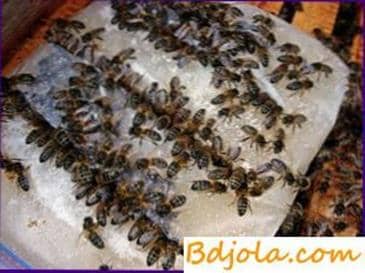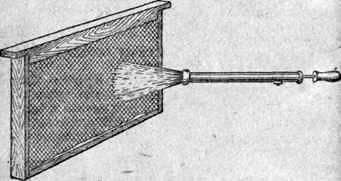Feeding bees

Feeding bees is a big and laborious work. Therefore, the apiaries should take measures to provide bee colonies with fodder, at least 18 kg of honey in the honeycomb, for each bee family for the winter-spring period. Such reserves are usually sufficient before the onset of favorable weather and the flowering of early honey-plants. In addition, it is necessary to have a honey insurance fund.
To substitute a top dressing it is necessary quickly not to cool nests of bees. If the weather is cold, then weak families will not take food from the feeding troughs set up at the bottom of the hive, in view of this it is much better to put the feeders on top of the framework or to strengthen them in the building framework.

Fig. Filling the honeycomb with syrup using a syringe.
Sometimes honey or sugar syrup is poured directly into empty honeycombs. This work, performed by two people, is done this way: one holds the honeycomb over the basin, and another uses a syringe to fill it from both sides. Filled honeycombs are put on a baking tray or iron sheet with bent edges, so that the drops falling from the honeycomb do not disappear. After 5-10 minutes honeycomb with sugar syrup can be carried along the hives. This method of giving liquid food to bees has a big drawback – it is not hygienic and completely inapplicable to apiaries where in previous years there was even a suspicion of brood and bee disease.
Feeders can be a different device. It is good to use a trough-frame in the form of a narrow and long, full-width frame, tin or wooden trough, about 10 cm deep, that is, of the size that can be put in a special, so-called building frame, if necessary. To prevent the tin from giving oxides and it was more convenient for the bees to climb, the troughs, before strengthening in a frame, are dipped in melted wax with rosin. In
It is better if the feeder has hangers the same as the frames. Such a feeder can be covered by a block of the building frame into which it is placed. A good feeder is also a glass jar, but it can only be used in those hives where the upper bars of the frames are not connected. A can of food is placed above the nest. For this purpose, take ordinary kilogram glass jars, fill them up with syrup or honey sated and tie with gauze (folded in half) or a clean rare piece of cloth, previously moistened with water. To tie it is necessary firmly, strong threads or twine and certainly so that the canvas was stretched, otherwise the food can pour out of the jar.
When the necessary number of cans with food is prepared, they are carried to the apiary and placed over the hives, and they are put in such a way: after covering this jar with a cardboard mug, quickly turn over the jar upside down and move the jar, put it on thin ones brusochki placed on top of the frame above the nest of bees and warmed. The food gradually seeps through the canvas, and the bees take it. As soon as the bees take all the food, immediately remove the jars from the hive, otherwise the bees can gnaw the bandages.
In addition to glass jars and feeders-frames, feeders of a different type are used for feeding bees, for example, in the form of wide, low drawers placed over the nest. In such feeders, special vertical corridors are sometimes made for the passage of bees. Plot in such feeders are mandatory.
Protein dressing. In spring, bees strongly need protein feed – pollen or perge. Flowers in this period, especially in April, is still too little, and bees in search of pollen have to make long flights, during which they die in greater numbers from the cold and wind. Therefore, we must carefully monitor the fact that the bees had stocks of perga, harvested last season.
Calculations show that for the normal development of the bee family during the first month after the exhibition from the hibernator, it should spend on average two or three well-filled frames for brood feeding. If there is not enough penguin in the hive, and there is no pollen in the nature either, the bee colonies are lagging behind in development: the uterus cuts the laying of eggs, and the bees even more reduce the brood rearing.
With protein starvation, printed brood on the framework is not continuous, but has a “latticed” appearance, since part of the larvae of 4-5-day-old age is thrown by bees from the cells. Such a phenomenon, for example, was massive in most apiaries, the backlog in the development of bee colonies, due to a lack of pollen and pergi, entailed late development of families, the worst use of the first bribes. All this has significantly affected the honey.
During protein starvation, the bee very well takes pollen-like food, for example, flour. There are cases when bees in the early spring time made a raid on the mills and in considerable quantities brought from there flour dust and flour.
The ability of bees to take flour has long been noticed by beekeepers, therefore some of them specially put flour on the apiary, usually scattering it on large flat iron sheets with curved edges. These sheets are put in places protected from the sun, and bees literally swarm in them.
However, studies show that such a feeding with flour is very little effective. The starchy grains of flour are many times larger in size than the pollen grains and are hardly digested by bees.
Partially can be assimilated specially prepared flour, for example, the so-called “baby flour”, as well as soybean and cotton, with small starch grains. Feeding such flour is somewhat more effective than ordinary.
Despite numerous studies of full-value substitutes, equal in importance to pollen and perge, it has not been found. Only pollen and perg are the most valuable protein-vitamin food, which is perfectly used by bees. But nevertheless there are a number of other protein foods that, although they can not completely replace pollen or pergu, are still fed to bees in the case of pollen starvation, which largely improves the condition of bee colonies and promotes their development. First of all, dry yeast and skimmed milk are among such foods.
These feeds are given along with the sugar syrup. As shown by the production experience at the Kiev beekeeping reference point, the bees take very well and effectively use yeast dressing, which is prepared from the calculation of 40-50 g of yeast diluted in 2 cups of boiling water (to kill yeast fungi), 1 liter of thick sugar syrup. Dissolve yeast mixed with syrup before feeding the bees. Such food is poured into beehive feeding troughs at the rate of 1 – 1.5 liters of each fed up family for one dacha.
In recent years, many beekeepers as a protein feed in the spring give bees fresh skimmed milk. It is also given in a mixture with sugar syrup. We only need to make sure that this food does not spoil, and therefore it should not be given more than a bee family can take in one night. Sometimes, bees are taught to take from fresh hives feed fresh milk instead of water, but in this case it should be given in very small portions and closely monitor its use by each family.
When feeding bees with protein foods, special attention should be given to the cleanliness of the feeders: before and after feeding, they must be carefully steamed in boiling water.
Feeding bees
